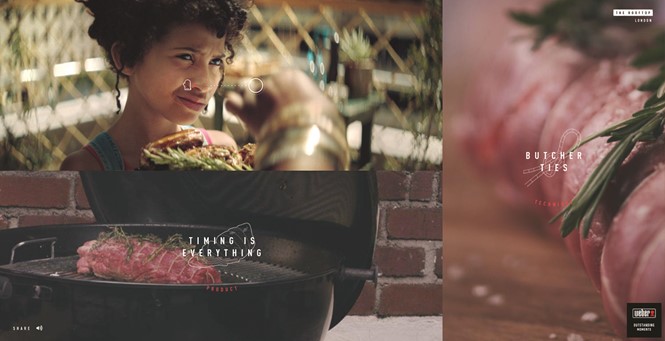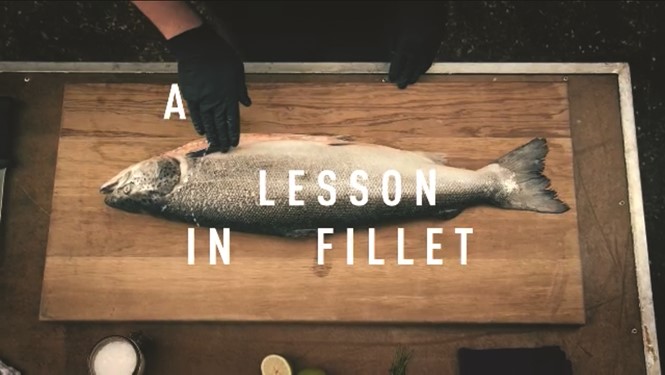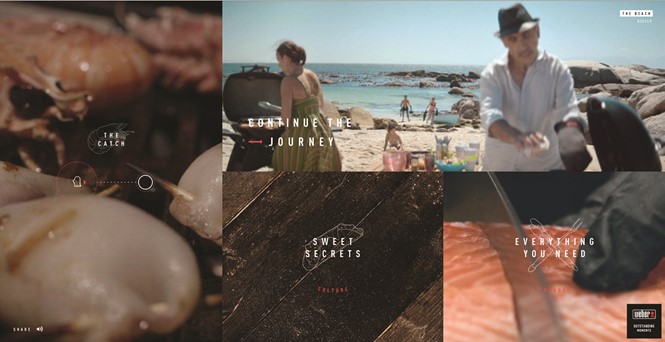Brand experience: Weber
User experience centred around moments, recipes and interactive content is the focus for a digital platform developed for barbecue purveyor Weber. How does its success reflect the brand’s approach to experience? Brittany Golob reports
A digital campaign that is story-led that gets people involved, share’s the brand’s positioning regarding experience and has the added bonus of generating sales is the holy grail for corporate digital work. Weber, the American-born, internationally-sold barbecue brand teamed up with Media Monks to achieve this success. The project, called BBQ Cultures, took just 10 weeks to
develop but ultimately got over 600,000 users to spend an average of four minutes in the experience and drove sales up by 300-400% for key products. “The aim of the project was not to push the sell, but to position the Weber brand as the provider of outstanding moments – and to show that we take ownership of building an impressive culture around our products,” says Stig Pedersen, Weber’s EMEA director of marketing.
“At any given time, somewhere in the world, someone is barbecuing,” begins the voiceover on BBQ Cultures, a web app that immerses users into the world of grilling. It begins with a short film depicting a group of friends grilling their catch from the day’s fishing before transitioning to further moments including a London rooftop celebration with jerk chicken stealing centre-stage, a Sicilian beach cookout, a German football match viewing party and an outdoor wedding in Provence. But the film vignettes were only one piece of the ever-moving puzzle that made up BBQ Cultures.
The user journey is guided by recipes, how-to clips, films and other signposts designed to immerse people in the world of barbecue. Media Monks ensured though, that this content would be accessed by no mere clicks, but by swipes. This tactile choice meant users would build a stronger connection with the content. Media Monks’ founder Wesley Haar says this mirrors the tactile nature of barbecue itself and is relevant due to the large portion of users accessing the content on mobile devices. Mobile use of BBQ Cultures was between 40% and 65%. “Mobile is super personal. If we bring brands into that space, you want them to have some of the similar interactions that people are using in that personal space – gestures, swipes, shakes. It connects more to people, it’s more memorable than a click. It’s trying to lead into the platform, not just make it a website that people will look at,” Haar says.
This immersive experience is not a first for Weber. It puts experience first in many brand touchpoints. Pedersen points out the Weber Original flagship store in Berlin and the company’s 100 Grill Academies, among other projects, that, “Sell experience around the grill.” Weber, though, he adds, is a product-oriented brand. But instead of going for the hard sell, particularly on digital, Weber focuses on selling a lifestyle. That way, it can build connections on an emotional level and get people interested in the opportunities afforded by grilling.
For that reason, the call to action for sales on BBQ Cultures is extremely light. “We do not want to push our customers to buy a product by ‘product, price and specs,’” Pedersen says. “We want to inspire them and, by that, lead them to a purchase decision.” Yet that light sell didn’t detract from the project’s impact on the bottom line. Haar says there was a strong uptick in sales directly related to BBQ Cultures with certain products up 300-400%, some people even wanted it to be easier to buy directly through BBQ Cultures.
User experience, though, is the heart of the project. Media Monks had to consider the way in which users on different devices would access BBQ Cultures and create an experience that would work on each platform. This process began at the outset, and allowed the content to be developed for mobile and social throughout the project. “We made everything bite- sized so it’s easy to share,” Haar says. That required two filming teams, one for the vignettes and the other for the moments that comprise the rest of the site – the transitions, recipes, additional content and added experiences.
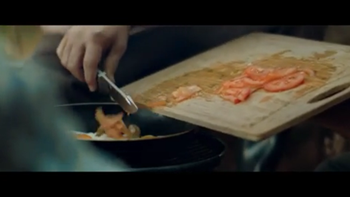
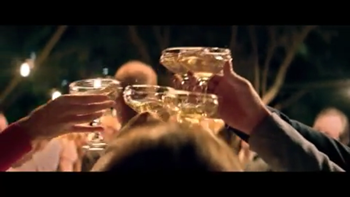
The content itself is geared around the lifestyle of grilling, as is most of Weber’s experiential work and brand strapline. Weber has been around for 61 years when a metalworker wowed his friends with steak cooked on the first lidded barbecue. George Stephen, Sr., the founder, toured the U.S. teaching people through demonstrations and television programmes how to grill on his dome-shaped barbecues. Experience has always been central to a Weber brand that now sells grilling products across America and around the world.
BBQ Cultures is only the latest extension of that focus. It depicts grilling styles and communal gatherings across different cultures to celebrate the variety of moments Weber can be involved in, Pedersen says. “We see it as our obligation to push the limit of grilling and to create the best barbecue culture around us...The world is diverse. We wanted to celebrate the unique world of possibilities around the many fantastic cultures.”
Haar’s Media Monks and Danish creative agency Uncle Grey brought this vision to life when filming. “One of the main insights and takeaways is that barbecue is a super-celebratory moment. We’re showing a few to get people to understand that you can always have a barbecue because it is a celebratory “It’s very forward moving for the brand,” Haar says. “A lot of brands devolve into lots of ‘buy-here’ buttons. But if we interest and inspire and instigate people to be involved, they’re going to buy the things that they need to get involved. I think we’re at a moment in time now where we have very mature audiences that are comfortable making decisions to buy products, but they spend a lot of time trying to get inspired or get a feel for what kind of product they should buy. I think a platform like this really opens that up.”
By integrating these types of content, and making them shareable via social, BBQ Cultures high average time spend was coupled with just a 7% bounce rate. The instructional, cultural and bite-sized content made for good social content, Haar says, because it’s not just beautiful or brand-based, but interesting and helps show the sharer in a good light. “It needs to be crafted, it needs to be interesting. It needs to be a very high level of work that’s very personal to them to give it a high chance of getting distributed,” he adds. BBQ Cultures was a success. Pedersen says, “We manage to take grilling to a completely new level, showing techniques in a way nobody did before. And we managed to inspire our consumers to do much more advanced cooking at their grill.”
But Weber has more plans for experiential projects in future. Alongside its cooking schools, existing digital content and interactive stores, Pedersen says Weber is working to bring out a ‘next gen’ barbecue app in 2016. The app will unlock new content every time it is used and will help people enhance their grilling skills.
Haar says Weber pushes digital to work for the brand. It does a lot of content creation that is relevant to its audience and is light on the sales messaging common in the sector. “They’re trying to create really high end quality content to match the quality of their products and of their shopping experiences,” he says. “It’s a really concerted effort to be an iconic brand.”

